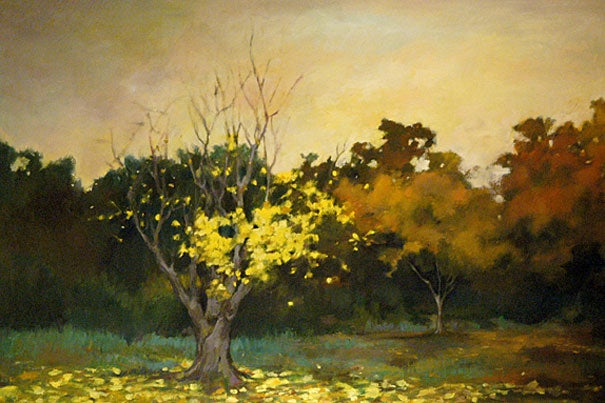
Courtesy of Sarah Leon
The artistic side of science
Medical school gallery turns busy hallway into thoughtful respite
Harvard Medical School (HMS) has acknowledged the fine arts in a big way. Its Countway Library of Medicine, an alliance with the Boston Medical Library, houses 100,000 photographs and prints, as well as an impressive collection of paintings.
Now HMS has acknowledged the fine arts in a fast way. The new Transit Gallery, about 30 yards of wall space along the lower level corridor of Gordon Hall, has just opened. It will host exhibits by local artists, mostly including works suggestive of the sciences.
The first show, “Water and Woods,” is up and will be on display through July 12. The artist, veteran painter and illustrator Sarah Leon, gave a talk at the show’s opening last month, on May 18. Her science theme concerned fluid dynamics. For her audience, largely made up of scientists, she created a watercolor of a tree. Its crown bled into the paper sky, and its trunk bloomed downward in a rootlike fuzz — showing fluids at work.
“The way colors move into each other is the secret to doing watercolors,” Leon said recently. She was back at the gallery to check up on the fate of her dozens of works arrayed along the busy space.
“Everyone says they know about art, but no one questions physics,” said Leon. “But there’s a lot of physics in watercolor. The way the water moves, you have to be in control of wetness.”
The Transit Gallery was named by artist and scholar Svetlana Boym, Harvard’s Curt Hugo Reisinger Professor of Slavic Languages and Literatures and professor of comparative literature. Last year, Boym helped to turn a little-used Harvard space on Chauncy Street into the idiosyncratic Arts @ 29 Garden. Tania Rodriguez, curator of the Transit Gallery, has a similar dream for the Gordon Hall corridor, as a place with both an artistic and an academic mission. “My job is to establish an identity for this space, and to create programs for it,” she said.
The little stretch of hallway has been used for exhibitions in the past, including one of photographs related to Partners In Health. In 2008 there was an exhibit of cigarette advertising, part of what was then the HMS campaign to have a smoke-free campus. (“People used to come from the hospitals to smoke on the Medical School campus,” said Rodriguez.)
Only one show over the years touched on the fine arts, but the space was nameless until this spring. “It was apparent that naming the space was important” to invited artists, said Rodriguez, who is a project coordinator with HMS human resources.
Local artists will be featured. The first show drew applicants through an “open call” made by the Office for the Arts at Harvard, Rodriguez said. In turn, Leon, who works at the American Repertory Theater, heard about the Transit Gallery through the Harvard Staff Artists Community, a collective of artist-employees formed last year. The Massachusetts Institute of Technology sponsors a similar group, Artists Beyond the Desk.
The Transit Gallery corridor is part of a network of basement walkways that connect the major buildings on the campus’ iconic quadrangle. That makes it an ideal space for Harvard students to pause, converse, and meet one another, said Rodriguez. “All along, this has been about community enhancement.”
Leon is a science-loving Watertown artist who has had shows in San Francisco, Chicago, and Baltimore (where she once had a solo show at the Space Telescope Science Institute).
In the Transit show, there are many examples of the miniature watercolor trees that she used to illustrate fluid dynamics. They are often arrayed in groups around a later picture — a fanciful golden toad, for instance, or a finely drawn pine cone or maple seedpod. “These are collected like a little poem,” said Leon of one set of miniatures. “Each tree is a feeling.”
Her work generally depicts open water, storm clouds, critters, and demons, but the trees dominate this exhibit.
“All I wanted to do at first was put you alone in nature,” said Leon, an all-weather artist who sets out to paint nature in every season. That can mean just seeing the magic in a single tree in an urban cemetery or street corner. In “Falling Yellow” she painted the autumn colors of the big maple tree at Brattle Street and Fresh Pond Parkway — but painted out the houses, “which is something I usually do.”
Her trees and seas are often lush and naturalistic. But some show the bruised darkness and deep reds that are more suggestive of human anatomy. “That one is old,” said Leon, standing in front of “Jaded,” a close-up study of a thick tree. “It’s seen everything. It’s got blood and bone in it.”
Scientists and artists are similar in that they work hard, benefit from seeing the world in new ways, and make deep investigations of the natural world. “You have to have that mystery — something you’re looking for,” she said.
But artists can study the natural world and then create something that requires no footnotes or acknowledgements of multiple authors. “I don’t thank the trees.”
In the end, the fine arts and the sciences share more than you might think, including a sense of fun. “Playful experiment is the essential core of creative and scientific inspiration,” said Leon, who once won a prize for depicting what a migraine looks like in the brain. “That thinking form of play leads to brilliant ideas.”
More than play is at work too. “There’s a lot of silly going on with science,” she said. “If you have to spend a lot of time squeezing eggs out of frogs, you have to have a sense of humor — I don’t care who you are.”
Share this article
Water and woods Paintings by Sarah Leon
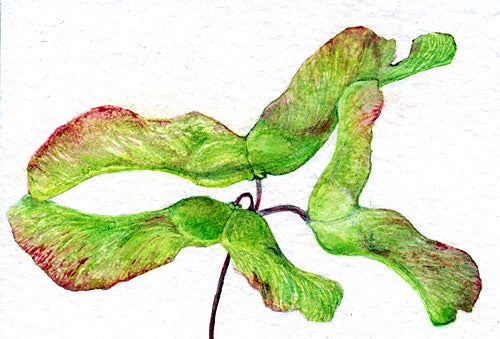
Maple Seeds
Work on paper
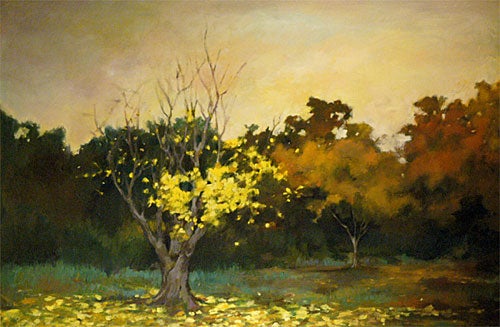
Falling Yellow
Oil on canvas
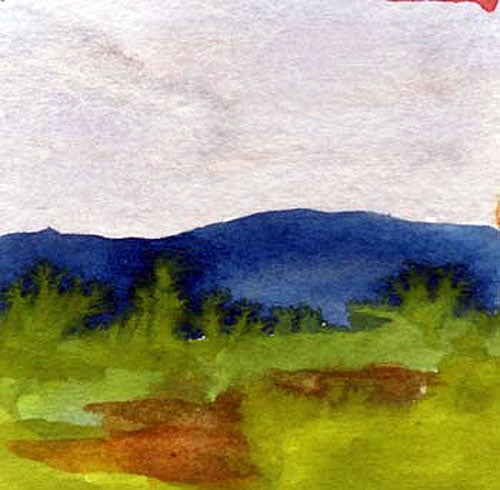
Spouts
Miniscape watercolor: Each painting in the Miniscapes series is only two inches square.
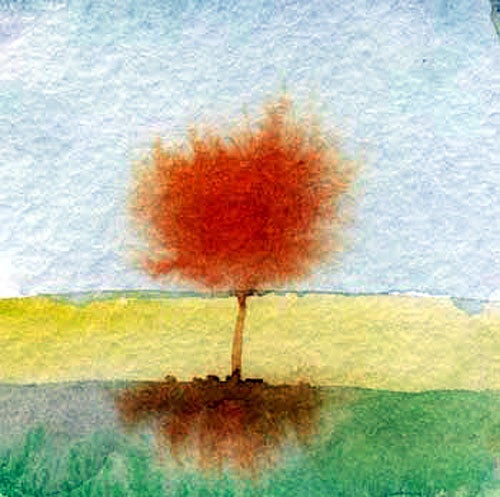
Miniscape
The paint must be coaxed and swirled like dropping milk into coffee. As one color mixes into the wet puddle of another, it changes and dries.
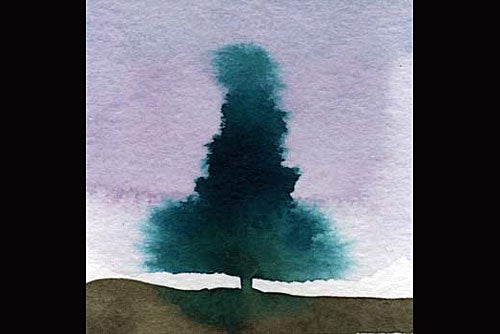
Big Pine
The tiny format of the Miniscapes series requires a spontaneous approach to watercolor.
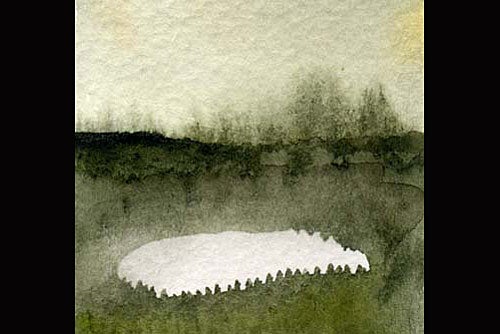
Reflect
Watercolor’s shifting nature leads to unexpected surprises.




